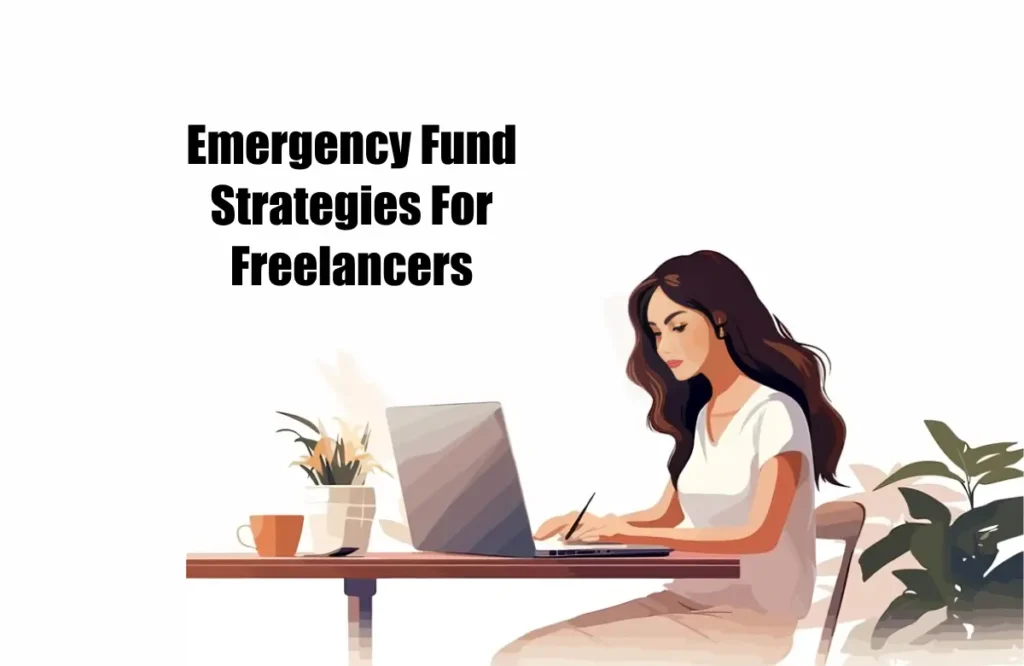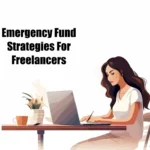you just scored a great freelance project, and you’re feeling on top of the world. But then, a few weeks later, the client delays their payment. Suddenly, you’re stressed about how to cover your bills. This unpredictable nature of freelance income can be tough, which is why having a financial safety net is so important. Freelancers face unique challenges that require some careful planning.
Why an Emergency Fund is Essential for Freelancers
For freelancers, having an emergency fund isn’t just a good idea; it’s a must. With income that can change from month to month, having some savings set aside gives you peace of mind. Unlike regular employees, freelancers often don’t get benefits like sick leave or paid time off.
If you get sick or need to take a break, you won’t earn money during that time. Plus, clients can sometimes delay payments, leaving you in a tight spot financially. There can also be slow periods in your industry when work is hard to find. An emergency fund acts like a safety cushion to help you through these tough times.
In this article, we’ll go over some key strategies for building and keeping an emergency fund as a freelancer. We’ll talk about how much money you should aim to save, tips for setting aside money regularly, and ways to manage your finances when things get slow. By creating a solid financial safety net, you can feel more secure as you navigate the freelance financial tightrope.
Defining Your Freelance Emergency Fund Target – The 6-12 Month Rule (and When It’s More)
When it comes to building an emergency fund as a freelancer, the standard advice is often to save three to six months’ worth of living expenses. However, this might not be enough for many freelancers. Given the unpredictable nature of freelance work, it’s wise to aim for a target of six to twelve months of essential expenses. In some cases, you may even want to save up to 18 months, especially if your industry is less stable or your income is inconsistent.
Standard Advice (3-6 Months) vs. Freelance Reality
The typical recommendation of three to six months of living expenses can fall short for freelancers. Unlike traditional employees, freelancers don’t have a steady paycheck or benefits like paid time off. If you lose a client or face a slow period, that cushion can disappear quickly. By aiming for six to twelve months of essential expenses, you give yourself a better safety net. In some industries, where work can be sporadic, saving even more—up to 18 months—might be necessary to feel secure.
Calculating Essential Business and Personal Expenses
To determine your emergency fund target, start by calculating your essential business and personal expenses. This breakdown is crucial for freelancers:Personal Expenses:
- Rent/Mortgage: Your monthly housing cost.
- Utilities: Electricity, water, gas, and internet bills.
- Groceries: Monthly food expenses for you and your family.
- Health Insurance: Monthly premiums for medical coverage.
- Loan Payments: Any personal loans or credit card payments.
- Transportation: Costs related to commuting or vehicle maintenance.
- Minimum Debt Payments: The least amount you need to pay on debts.
Business Expenses
- Essential Software Subscriptions: Tools you need for your work.
- Website Hosting: Costs for maintaining your online presence.
- Marketing Costs: Expenses related to promoting your services.
- Professional Dues: Membership fees for industry organizations.
- Insurance: Liability or professional indemnity coverage.
- Estimated Taxes: Setting aside money for tax obligations.
Considering Income Volatility and Industry Factors
Finally, consider your income volatility and industry factors when setting your emergency fund target. If you work in a field with frequent ups and downs or have inconsistent clients, aim for a larger fund. The more unpredictable your income is, the more savings you’ll need to feel secure during lean times.
By carefully assessing your situation and planning accordingly, you can build an emergency fund that truly protects you as a freelancer.
The 6-12 month rule (or even more), you’ll create a solid financial foundation that allows you to focus on your freelance work without constant worry about money
Building Your Freelance Emergency Fund -Actionable Strategies
Building your freelance emergency fund doesn’t have to be overwhelming. With a few actionable strategies, you can create a solid financial cushion that gives you peace of mind. Let’s explore some practical steps to help you get started.
Open a Separate High-Yield Savings Account (HYSA)
The first step is to open a separate high-yield savings account (HYSA) for your emergency fund. Keeping your emergency savings separate from your operating funds makes it easier to track your progress and helps you avoid accidental spending. Plus, HYSAs typically offer higher interest rates than regular savings accounts, allowing your money to grow while you save. This means that every dollar you set aside works a little harder for you.
Automated Transfers – Set It and Forget It
Next, consider setting up automated transfers from your business checking account to your HYSA. This way, saving becomes effortless. You can schedule transfers after each client payment or set a regular schedule, like weekly or monthly. Once it’s set up, you won’t have to think about it again. This “set it and forget it” approach makes saving a habit rather than a chore.
Percentage-Based Saving from Each Payment (The “Profit First” Approach)
Another effective strategy is to use the “Profit First” approach by allocating a fixed percentage of each client payment directly to your emergency fund. Aim for 10-20% or more, depending on your income and savings goal. By integrating saving into your business model, you ensure that you’re consistently building your fund without feeling the pinch.
Treat Windfalls as Emergency Fund Accelerators
Don’t forget about windfalls, Treat any unexpected income—like bonuses, tax refunds, or gifts—as an opportunity to boost your emergency fund. Deposit this extra cash directly into your HYSA to reach your target faster. This way, you can make the most of those surprise financial boosts.
Also Read: Debt Management For Recent Graduates
Aggressively Cut Unnecessary Expenses
To build your emergency fund even quicker, consider cutting unnecessary expenses in both your business and personal life. For business expenses, negotiate better rates with vendors, review software subscriptions for any that you don’t use, and consider coworking space alternatives if they’re too pricey. During slow periods, reduce marketing spend to save more.
On the personal side, look for ways to cut back on dining out, entertainment, and non-essential subscriptions. Every little bit helps when it comes to building your fund.
“Micro-Saving” Apps and Techniques
Finally, explore “micro-saving” apps like Acorns or Digit. These apps round up your purchases to the nearest dollar and automatically save the spare change for you. They make saving easy and fun by helping you put away small amounts without even noticing it.
Optimizing Your Emergency Fund – Accessibility and Growth
When it comes to building your emergency fund, optimizing how and where you save is essential. You want your money to be safe, easily accessible, and earning interest. Let’s explore some great options for maximizing your emergency fund.
High-Yield Savings Accounts (Again, Key Recommendation)
One of the best places to keep your emergency fund is in a high-yield savings account (HYSA). These accounts offer better interest rates than regular savings accounts, allowing your money to grow while remaining accessible. When choosing a bank, compare interest rates and fees. Many online banks offer competitive rates without maintenance fees, making them a great choice for your emergency savings.
Money Market Accounts (For Larger Funds)
If you have a larger emergency fund, consider a money market account. These accounts typically offer slightly higher interest rates than HYSAs but may come with some withdrawal restrictions. Money market accounts can provide check-writing privileges or debit card access, making it easy to access your funds when needed. Just be sure to check the terms and conditions regarding withdrawals.
CDs (Certificate of Deposit – Not Recommended for Emergency Funds)
While certificates of deposit (CDs) might seem like a tempting option due to their fixed interest rates, they are not suitable for emergency funds. CDs lock your money away for a set period, and withdrawing early often comes with penalties. Since emergencies can happen at any time, you need your funds available without restrictions.
Absolutely Avoid Investing Emergency Funds (Key Point)
A crucial point to remember is that you should absolutely avoid investing your emergency fund in stocks, bonds, or other volatile assets. While investing can be great for long-term growth, it puts your emergency savings at risk. You want your emergency fund to be in safe, liquid accounts so you can access it quickly when unexpected expenses arise.
Maintaining and Using Your Emergency Fund Responsibly
Having an emergency fund is just the first step; maintaining and using it wisely is just as important. With a few simple strategies, you can make sure your emergency fund stays a reliable safety net for unexpected expenses. Let’s look at how to do this effectively.
Regularly Review and Adjust Your Budget and Target
First, it’s important to regularly check your budget and adjust your emergency fund target as your life changes. If your income goes up or you have new expenses like higher rent or a new family member you may need to save more. Life can change quickly, so keep an eye on your finances and update your emergency fund goals when needed. This way, you’ll always be ready for whatever surprises come your way.
Replenish After Withdrawals Immediately
If you ever need to use your emergency fund, make it a priority to refill it right away. Treat this like a top financial goal, For example, if you take money out for an unexpected car repair, plan to add that amount back into your fund as soon as possible. Setting up automatic transfers can make this easier and help you stay on track.
Clearly Define What Constitutes a True Emergency
To use your emergency fund responsibly, clearly define what counts as a true emergency. Real emergencies might include unexpected medical bills, essential car repairs needed for work, or losing a major client suddenly. By having specific rules, you can avoid taking money out for non-emergencies like impulse buys or minor issues.
Tracking Withdrawals and Replenishments
Finally, keep track of all withdrawals and replenishments in your emergency fund. You can use a simple spreadsheet or a budgeting app to monitor what’s happening with your fund. This way, you’ll know how much you’ve spent and how much you need to save back. Regular tracking helps you stay accountable and ensures that your emergency fund is there when you really need it.
Maintaining and using your emergency fund responsibly, you’ll create a solid financial cushion that lets you handle life’s surprises with confidence
Integrating Emergency Fund Planning With Other Financial Goals
As a freelancer, managing your finances can feel like a juggling act. One of the key challenges is integrating emergency fund planning with other financial goals. With some thoughtful strategies, you can balance debt repayment and savings while setting yourself up for future success. Let’s explore how to do this effectively.
Balancing Debt Repayment and Emergency Savings
First, it’s important to find a way to prioritize both debt repayment and building your emergency fund. If you have high-interest debt, like credit cards, focus on paying that down first. However, don’t neglect your emergency fund entirely.
Aim to save a small amount each month while also tackling your debt. For instance, consider setting aside a percentage of each payment you receive for your emergency fund. This way, you’re making progress on both fronts without feeling overwhelmed.
Setting Long-Term Savings and Investment Goals (After Building the Fund)
Once you’ve built a solid emergency fund, you’ll feel more confident pursuing other financial goals. Having that safety net allows you to focus on long-term savings and investments without constant worry about unexpected expenses. Start thinking about retirement savings and other investment opportunities. With your emergency fund in place, you can take calculated risks that align with your financial aspirations.
Integrating emergency fund planning with your overall financial goals is essential for freelancers. By balancing debt repayment and savings, you’ll create a strong foundation for your financial future. With a solid emergency fund, you can confidently explore new opportunities and work toward achieving your dreams.
Securing Your Freelance Financial Future
As we wrap up, let’s recap the key strategies for securing your freelance financial future. First, prioritize building a solid emergency fund to protect yourself from unexpected expenses. Consider using high-yield savings accounts and automating your savings.
Balance your debt repayment with your emergency fund goals, and remember to clearly define what constitutes a true emergency. Finally, regularly review and adjust your budget to stay on track.
Building a strong emergency fund is crucial for freelancers. It provides financial stability, peace of mind, and the ability to weather any financial storm. With a reliable safety net in place, you can focus on growing your business without the constant worry of unexpected costs. Remember, every small step you take toward building your fund adds up over time.
Now it’s time to take action, Start implementing these strategies today. Whether it’s opening a high-yield savings account or setting up automatic transfers, every effort counts. Take charge of your finances and secure your freelance financial future. You’ve got this.
FAQ
What is an emergency fund?
An emergency fund is a savings account set aside for unexpected expenses, such as medical bills, car repairs, or job loss.
How much should I save in my emergency fund?
Aim to save at least three to six months’ worth of living expenses. Freelancers may want to save more, depending on income stability.
Why is having an emergency fund important for freelancers?
Freelancers often face income fluctuations and lack employer benefits. An emergency fund provides financial security during unexpected situations.
Where should I keep my emergency fund?
It’s best to keep your emergency fund in a high-yield savings account or a money market account for easy access and growth.
How can I start building my emergency fund?
Begin by setting a savings goal and contributing a fixed amount each month. Automate transfers to make saving easier.
Should I use my emergency fund for non-emergencies?
No, only use your emergency fund for genuine emergencies like medical expenses or urgent home repairs to maintain its purpose.
What if I need to withdraw from my emergency fund?
If you withdraw funds, prioritize replenishing it as soon as possible to ensure you have enough for future emergencies.
Can I invest my emergency fund?
No, it’s important to keep your emergency fund in safe, liquid accounts. Investing it in volatile assets puts your savings at risk.
How often should I review my emergency fund?
Regularly review your budget and adjust your emergency fund target as your income and expenses change, ensuring it meets your needs.








